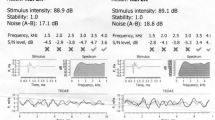Abstract
In newborns, both term and preterm, cochlear hearing loss is common due to different pathologies. Currently accepted methods for hearing screening in newborns are otoacoustic emission (OAE) and auditory brainstem responses. Among these two, OAE is quicker, economical and more accessible. In the present study we assessed OAEs in sick newborns, both term and preterm, having different pathological conditions. This descriptive study was conducted over 3 months in sick newborn care unit (SNCU) in a tertiary care hospital. All sick newborns admitted to SNCU in the study period were tested for otoacoustic emission. The results were subjected to the Chi square test (test of independence). Among 640 sick newborns, 184 were preterm; the rest being term newborns. Among the term sick newborns, 4.8% of those with birth asphyxia, 8.6% of those having septicaemia, 25% of those with hyperbilirubinemia needing exchange transfusion, 22.9% of those having meningitis and 33.3% of those with major congenital anomalies, had “refer” on OAE. Among preterm sick newborns, 30.8% of those with birth asphyxia, 32.5% of those having septicaemia, 75% of those with hyperbilirubinemia needing exchange transfusion, 41.7% of those having meningitis, 40% of those with major congenital anomalies and 8.7% of those with no co-morbidity had “refer” on OAE. Upon computing the p value of Chi square test performed on the results, the results were not significant (p = 0.85). Hence we didn’t find any statistically significant difference between term and preterm sick newborns on OAE. The incidence of “refer” result in OAE increases with co-morbidities in both term and preterm sick newborns, somewhat more in preterm newborns. But preterm sick newborns do not seem to have an increased incidence of hearing impairment.
Similar content being viewed by others
References
Mohamed MT, Fatemeh E, Faranak E (2008) Auditory evaluation of high risk newborns by automated auditory brain stem response. Iran J Pediatr 18(4):311
MacDonald M, Seshia G, Mary MK, Mullett N, Martha D (2005) The vulnerable neonates and neonatal intensive care environment. In: Avery’s neonatology pathophysiology and management of the newborn, 6th edn. Lippincott Williams and Wilkins, Philadelphia, pp 118–119
Hall WJ, Mueller GH (2000) Auditory brainstem response. Audiologists’ desk reference 1:319–87
Escobar-Ipuz FA, Soria-Bretones C, Garcia-Jimenez MA, Cueto EM, Torres Aranda AM, Sotos JM (2019) Early detection of neonatal hearing loss by otoacoustic emission and auditory Braintem response over 10 years of experience. Int J Pediatr Otorhinolaryngol 127:109647
Paul A, Prasad C, Kamath SS, Dalwal S, Nair MKC, Pagarkor N (2017) Consensus statement of the Indian Academy of Pediatrics on Newborn Hearing screening. Indian Pediatr 54:647–652
Gouri ZUH, Sharma D, Berwal PK, Pandita A, Pawar S (2015) Hearing impairment and its risk factors by newborn screening in north-western India. Matern Health Neonatol Perinatol 1:17
Morales SG, Poblano A, Galvan AR, Carrocera LF (1997) Auditory evoked potentials in children at neonatal risk for hypoacousis. Rev Panam Salud 2:15
Menkes JH, Harvey BS, Bernard LM (2006) Child neurology, 7th edn. Lippincott Williams and Wilkins, Philadelphia, pp 17–18
Author information
Authors and Affiliations
Corresponding author
Additional information
Publisher's Note
Springer Nature remains neutral with regard to jurisdictional claims in published maps and institutional affiliations.
Rights and permissions
About this article
Cite this article
Basu, M., Khaowas, A.K. & Kumar, S. Otoacoutic Emission Testing in Preterm and Term Sick Newborns: A Comparative Analysis. Indian J Otolaryngol Head Neck Surg 74 (Suppl 1), 252–254 (2022). https://doi.org/10.1007/s12070-020-02049-8
Received:
Accepted:
Published:
Issue Date:
DOI: https://doi.org/10.1007/s12070-020-02049-8




